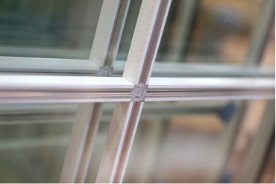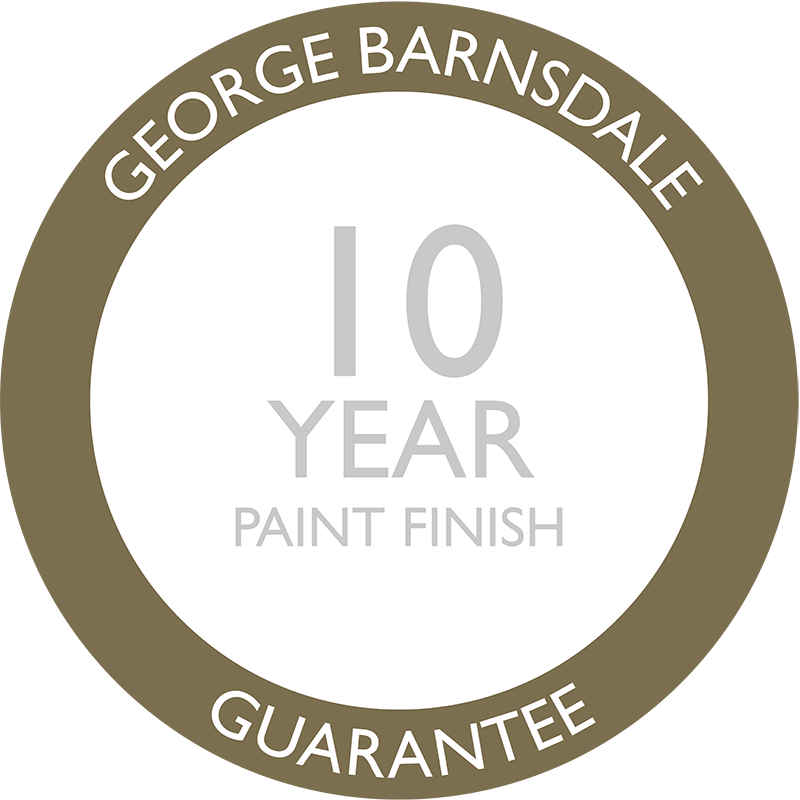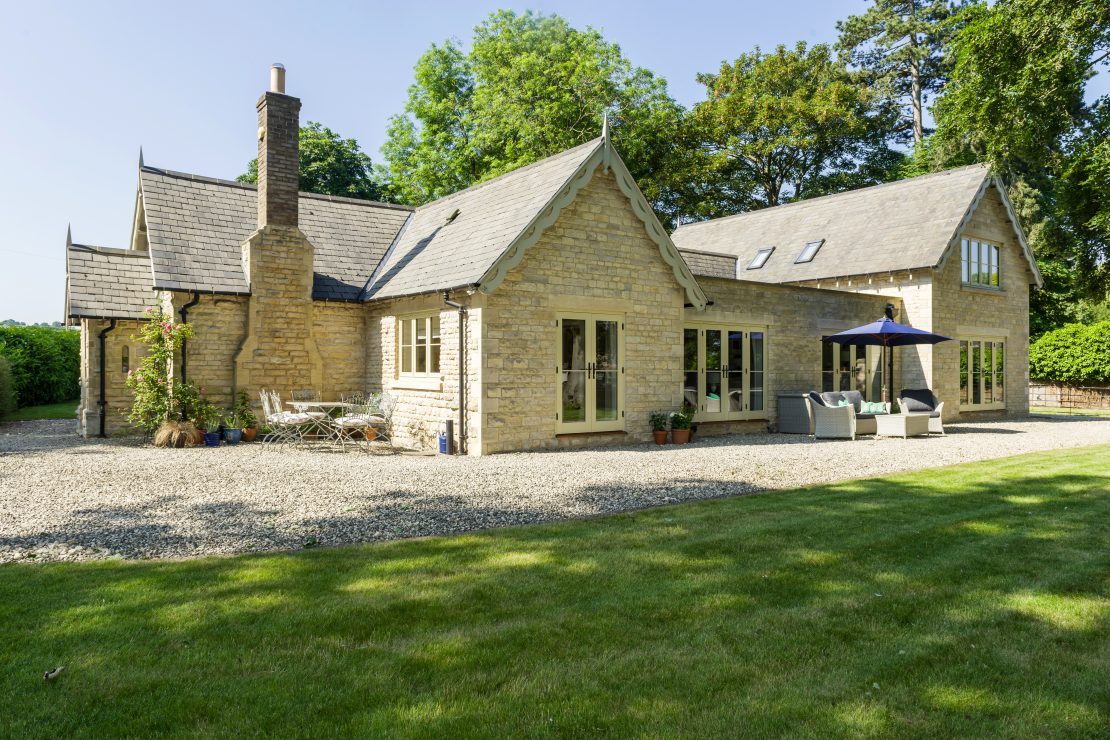April 15, 2025
At George Barnsdale, we speak to dozens of homeowners who are interested in adding timber windows to their upcoming house build, or replacing their existing windows with a set of stunning timber frames. Whilst many of our customers love the appearance of wood, they can sometimes find the choice of different timbers to be overwhelming at first!
That’s why we’ve put together this handy guide to the different types of timber on the market that can be used for window frames. In this article, we’ll describe the most common types of timber, the characteristics of each one, and the unique benefits that each type of wood can offer. Read on to learn more about which options are available for your timber windows, and get the information you need to make the best decision for you, your family, and your home.
Why choose timber windows?
Although man-made materials such as uPVC are commonly used to construct window frames in the UK, timber windows are still a popular design choice among homeowners, and architects alike. A consumer survey conducted by the British Woodworking Foundation (BWF) on a sample of 1,500 homeowners found that 59% of homeowners felt that timber windows offered a wide variety of style and design options.
The aesthetic appeal of timber windows is undeniable. They bring a natural beauty and charm that can not only elevate the exterior appearance of your home, but timber offers unrivalled versatility in design and style, meaning that they can be crafted to your home’s architectural style. Timber windows aren’t only timeless, but they offer a wide range of benefits to homeowners, including:
- Heat and energy efficiency. Timber windows, with their dense, sturdy construction, are much more heat and energy-efficient than many homeowners realise (with the BWF even releasing a report to dispel these misconceptions). Compared to alternate types of window material, timber windows are highly effective at maintaining steady temperatures within homes.
- Longevity and performance. With proper care and maintenance, timber window frames can last up to 60 years or more, and are more scratch-resistant and less prone to unattractive surface cracks than uPVC frames.
- Sustainability. When choosing a supplier for your timber windows, opting for a manufacturer that prioritises the use of ethically sourced wood will reduce the overall environmental impact of your home build. Timber is a naturally sustainable material, which can be harvested in a way that minimises waste.
Types of Timber used for Timber Windows
If you’ve decided that timber windows are the right choice for your home build, the next thing you’ll want to consider is which type of timber you’d like to use. At George Barnsdale, we offer four high-performing types of timber for our timber windows, including engineered redwood, European oak, Accoya® and Grandis hardwood.
We’ll discuss the unique characteristics of each of these timber types below.
Engineered Redwood
Engineered redwood is an attractive, yet durable material made by laminating high-quality cuts of European redwood to produce a stronger, more weather-resistant material, perfect for timber windows and doors. European redwood, also known as Scots Pine (UK), Baltic redwood, or Baltic redwood, is a slow-growing softwood with a dense grain, making it more robust and hard-wearing.
Engineered redwood is an excellent choice for products requiring a paint finish, as the stability of the timber enhances the coating’s lifespan. As this timber is naturally resistant to both decay and pests, it’s a great choice for cold and wet climates like Great Britain. It can also be a good option for properties that are on the coast or close to bodies of water, where burrowing insects are often found.
Some benefits of choosing engineered redwood for your timber windows include:
- Strength and longevity. For its weight, engineered redwood is strong and moderately hard. Engineered wood can often outperform solid timber, due to the mix of different grains and the addition of both chemical treatments and adhesives, which results in a sturdy building material which can stand the test of time.
- Weather resistance. The timber used to produce engineered redwood is a dense, close-grain wood which is naturally resistant to both moisture and weather damage. It is found in the mountains of Spain and in the UK, especially in Scotland, so is used to varying climates.
- Appearance. Redwood features beautiful colours in warm red and brown hues, which can compliment both contemporary and historic properties. Whereas the sapwood is creamy-white to yellow in colour, especially in northern environments.
European Oak
European oak, also known as English oak, French oak, or Polish oak, certainly earns its reputation as a sturdy building material, and is a popular choice for timber windows and doors. This durable hardwood and the enhanced, laminated versions often used by building professionals offers high performance and an attractive finish, due to its refined grain and yellow-brown colour. However, it is important to note that because of its qualities, European oak is more costly compared to other timbers available.
If you’re interested in using European oak for your timber windows, some of the best features of this timber are:
- Sturdy by design. As one of the most popular hardwoods used in construction, European oak is naturally strong. When combined with lamination processes, which utilise the best cuts of wood and remove weak points such as knots, the European oak used in construction is both reliable and long-lasting.
- Minimal expansion and contraction. Compared to other types of timber, European oak is less prone to expand or contract based on changes in weather and humidity. This makes it a good choice for changeable climates, as well as areas with high rainfall. However, it does have a tendency to move, which is why we use knot-free laminated European oak.
- Versatile. European oak is an ideal timber to be painted or finished in whichever way you choose, meaning that it can be easily matched to the colour scheme and design of your property.
Accoya®
Accoya® may not be as well-known as the more common timbers used in construction, like oak or redwood, but this material is growing in popularity, particularly for outdoor uses such as windows, doors, and garden furniture. It has been rated as one of the most durable timbers on the market today, due to a manufacturing process that’s used to strengthen the wood.
Accoya® is an excellent match for our four-stage paint process, and its ability to maintain a finish is one of the reasons that we recommend Accoya® wood for use in coastal areas with high winds and humidity. We also recommend Accoya for coastal areas as it isn’t detrimentally affected by salt water contact or immersion.
- Highest durability rating of any timber. Accoya® wood, while it begins its life as a softwood, undergoes an innovative treatment to strengthen it. This makes it more durable and long-wearing than many of the other timber types available on the market.
- Customisable. Accoya® wood provides a smooth, effective base for paints and varnishes, so your timber windows can be tailored to fit the appearance of your home.
- Guaranteed, long-lasting performance. This timber is highly reliable, meaning that manufacturers of timber windows are able to provide guarantees that their Accoya® window frames will perform well across their lifetime. It is also indigestible to a wide range of pests, providing an effective barrier of attack.
Grandis Hardwood
Hardwood is often a popular choice for the construction of timber windows, and Grandis Hardwood, otherwise known as Rose gum, Flooded gum, or Red grandis, is no exception. With its varying colours of almost white to light pink, and even dark red, and attractive grain pattern, Grandis Hardwood is perfect for the exterior of your home, and often used for exterior windows, doors, decking, and outdoor furniture.
Grandis is native to eastern Australia, with a number of large plantations established in South America and South Africa. Its strength is comparable to European Oak, is slightly cheaper to oak, making it the more popular choice between the two.
For decades of use and a timber that won’t tarnish easily, we often recommend this wood for window frames, for its following benefits:
- Perfect material for a stain finish. Many people enjoy the appearance of Grandis hardwood, and prefer it in its natural state rather than painting over the grain. Luckily, this wood pairs particularly well with a stain finish, meaning you can customise your timber frames while still keeping the attractive look of the wood.
- Laminated structure for extra stability. With its three-ply laminated structure, engineered Grandis hardwood, like the timber we use for our frames, offers greater strength and durability than in its raw form.
- Naturally resistant to pests and rot. This hardy timber is resistant to damp, rot, and burrowing insects, making it an ideal choice for the wet British weather.
What type of timber should I choose for my windows?
Now that we’ve outlined the different types of timber available for the construction of timber windows, you may already have a preference in mind for your own home. It’s easy to focus mainly on the wood’s colour and appearance, but there are some other factors we’d recommend considering when it comes to making your final selection. For instance, the location of your home, what the typical climate is (is it humid? Dry?) and what type of window frame you’re planning to install.
We’ll go over each of these in more detail below, to help ensure that you’re making the best and most informed decision for your choice of window frame material.
Things to consider before choosing your timber window material
Location
One of the key things to bear in mind when selecting a suitable material for your timber windows, is the geographical location of your home. For instance, if you live in a coastal area or own a seafront property, you should look for timber which can stand up well against wind and high humidity (such as Accoya®). Similarly, if you live near a forest or wooded area, you may benefit from choosing a close-grain wood which is naturally resistant to pests.
Not such an issue in a place like the United Kingdom, but for sunny places, you should also consider the lifespan and future maintenance of your wood. Some types of timber are more prone to sun-bleaching, and may need more frequent treatments or regular stains to maintain the appearance.
Climate
As well as high humidity, as mentioned above, it’s also worth making a note of the average temperature at different times of year when choosing timber windows. Again, while the UK typically enjoys fairly mild and temperate weather, some types of timber are more suited to significant temperature changes.
For instance, if you live in an elevated area where it gets particularly cold and is prone to snow, you’ll want to select a timber that is less likely to shrink during cold snaps. Shrinking can lead to cracks and warping of a timber window frame over time, so to guarantee the best performance, we’d recommend a hardy, weather-resistant timber like European oak.
Hardwood or softwood
When hearing about the two common categories used to label timber, hardwood and softwood, many people may assume that hardwood is always the better choice. However, this isn’t always the case. The terms “hardwood” and “softwood” aren’t relative to how strong the material is, but the type of tree the timber comes from.
Hardwood comes from deciduous trees (trees which lose their leaves at certain points of the year), whereas softwood comes from trees which maintain their foliage all year round. So, don’t be concerned if your preferred timber for your window frame is a “softwood” — this only denotes the type of tree the wood was sourced from, and softwood can be just as long-lasting and high-performing as hardwood when it comes to window frames.
For more information on hardwood and softwood, check out our article: Hardwood or softwood – which is best?
Sustainability
If sustainability is something that’s important to you, and you’re trying to keep the environmental impact of your home build or renovation as low as possible, your choice of timber can be a great way to turn your values into action. Though timber as a whole is a more sustainable material than uPVC, some varieties have an even lower than average environmental impact, so are popular choices with homeowners and ethical builders alike.
To ensure that your timber choice is certified as sustainable, look for brands and suppliers using the Forest Stewardship Council (FSC) logo. This FSC scheme is aimed at consumers, and helps them to identify timber products which are ethically sourced and sustainable.
Budget
Whether you’re replacing your current window frames, or integrating the cost of window frames into the budget for an upcoming house build, it’s good to have a general estimate of what you’d be happy to spend on your timber windows. You can use this figure to help guide conversations with your timber windows supplier, who will also be best-placed to advise you on the benefits of different timber types, and which will be most cost-effective for your home.
If you’d like to discuss your upcoming build or gain some more insights into installing timber windows in your current property, you can contact us to speak to a member of the George Barnsdale team. Our team of experts can talk you through your options, while keeping your spec requirements and budget firmly in mind.
Discuss your Timber Window project with George Barnsdale
While we hope that the information included in this article about different types of timber and their benefits has been useful, we also understand that this is an important decision, and you may wish to discuss your options with an experienced professional. If you’d like to speak to a member of our team of dedicated timber window experts, feel free to submit an enquiry via our website, and we’ll be in touch shortly to discuss your project.




















